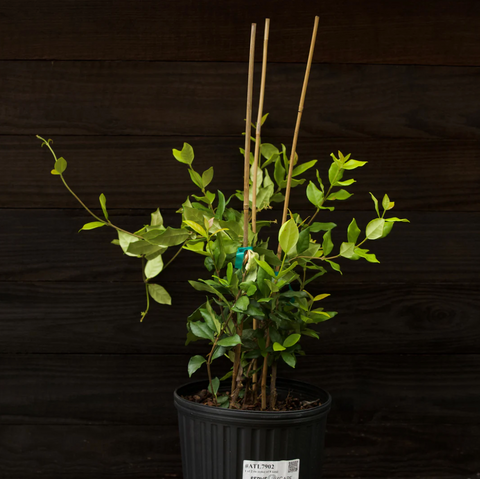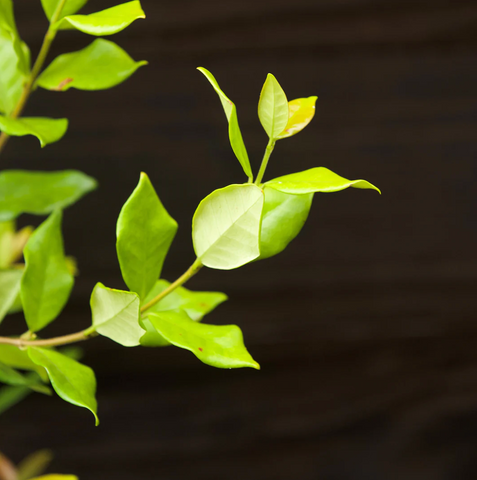Growing and Caring for Trachelospermum Jasminoides—Confederate Jasmine, Star Jasmine
Trachelospermum jasminoides, also known as Confederate Jasmine or Star Jasmine, is a popular climbing vine that is loved by many Georgia gardeners for its beautiful white flowers and glossy, dark green leaves.
In this article, we will explore everything you need to know about growing and caring for this delightful plant.
Traits of Trachelospermum Jasminoides

IMAGES: Servescape, Confederate Jasmine, Star Jasmine
Origins and Characteristics
Trachelospermum jasminoides is a member of the Apocynaceae family and is native to East and Southeast Asia, particularly China, Japan, and Korea. This vine is an evergreen plant that can grow up to 20 feet in length (with support) and has a moderate growth rate.
It produces fragrant, white, star-shaped flowers that bloom throughout the spring and summer months. Its leaves are dark green, glossy, and leathery, making it an attractive addition to any garden.
One interesting fact about Trachelospermum jasminoides is that it is not actually a true jasmine, despite its common name. It is, however, often used as a substitute for true jasmine due to its similar fragrance and appearance.
This plant is also known for its medicinal properties. In traditional Chinese medicine, Trachelospermum jasminoides is used to treat a variety of ailments, including headaches, fever, and inflammation.
Common Names and Varieties
Trachelospermum jasminoides is commonly known as Confederate Jasmine or Star Jasmine. There are many different varieties of this plant available, each with its unique characteristics and growth habits. Some of the most popular varieties include:
- 'August Beauty' - with more compact habit and larger flowers
- 'Madison' - with larger and more fragrant flowers
- 'Frostproof' - more cold-tolerant than other varieties
- 'Variegatum' - with variegated leaves
Benefits and Uses
Monrovia’s Confederate Jasmine/Star Jasmine is a versatile plant that can be used in many different landscaping applications. Its beautiful flowers and foliage make it an excellent choice for covering walls, trellises, arbors, and fences. It can also be grown as a ground cover or used as a container plant.
In addition to its aesthetic benefits, Confederate Jasmine/Star Jasmine also has practical uses. Its dense growth habit makes it an effective privacy screen, and it can help to reduce noise pollution in urban areas.
Furthermore, this plant attracts pollinators like bees and butterflies, making it a beneficial plant for the ecosystem. It also has a calming effect on the mind and body, making it a popular choice for aromatherapy and relaxation.
Planting and Propagation

If you're looking for a beautiful and fragrant vine to add to your greater Atlanta area garden, Confederate Jasmine/Star Jasmine is an excellent choice.
This evergreen vine produces clusters of small, white, star-shaped flowers that emit a sweet fragrance, making it a favorite among gardeners.
Choosing the Right Location
When choosing a location to plant your Confederate Jasmine/Star Jasmine, it's essential to consider the amount of sun and shade the plant will receive. This plant prefers partial shade to full sun and thrives in well-drained, moist, and fertile soil. It's also important to factor in the support structure the vine will need to grow properly.
Consider planting your Confederate Jasmine/Star Jasmine near a fence, trellis, or arbor, as these structures can provide the necessary support for the vine to grow and climb. You may also want to consider planting it near a seating area or window where you can enjoy its fragrant blooms.
Soil Preparation and Requirements
Before planting, it's important to prepare the soil correctly. Confederate Jasmine/Star Jasmine grows best in loamy, well-drained soil with a pH between 6.0 and 7.0. Incorporating organic matter into the soil, such as compost or peat moss, can improve soil quality. Adding mulch around the base of the plant can help retain soil moisture, prevent weeds, and regulate soil temperature.
Ensure that the soil is free of rocks and debris, as this can impede the growth of the plant's roots. If you're planting in an area with heavy clay soil, consider amending the soil with sand or perlite to improve drainage.
Planting Techniques and Tips
When planting Confederate Jasmine/Star Jasmine, dig a hole that's twice the size of the plant's root ball and place it in the hole. Backfill the hole with soil and water thoroughly. Make sure to provide support immediately after planting, as the vine will need a structure to climb up. It's also crucial to keep the plant well-watered, especially during the first few weeks after planting.
Consider adding a slow-release fertilizer to the soil when planting to provide the plant with the necessary nutrients to thrive. You may also want to consider pruning the plant regularly to maintain its shape and promote healthy growth.
Propagation Methods
Confederate Jasmine/Star Jasmine can be propagated through stem cuttings or layering. Stem cuttings should be taken in the spring or summer and planted in moist, well-drained soil. Layering involves bending a stem to the ground and covering it with soil, where it will develop roots. Once rooted, the new plant can be separated and transplanted to a new location.
Propagation can be a fun and rewarding way to expand your garden and share your love of plants with others. Consider propagating your Confederate Jasmine/Star Jasmine to share with friends and family or to create a beautiful and fragrant display in your garden.
Caring for Your Confederate Jasmine/Star Jasmine

In this section, we'll explore the best practices for watering, fertilizing, pruning, and pest control to help you keep your Confederate Jasmine/Star Jasmine healthy and thriving.
Watering Requirements and Schedule
Confederate Jasmine/Star Jasmine requires regular watering, especially during the first few years of establishment. This plant prefers well-draining soil that is moist but not waterlogged. If the soil is too dry, the plant may wilt and drop its leaves.
Once established, it can tolerate occasional drought conditions but still needs to be watered during prolonged dry spells. It's best to water deeply once a week rather than shallow watering. However, be careful not to overwater the plant, as this can lead to root rot.
Fertilization and Nutrient Needs
Confederate Jasmine/Star Jasmine is a light feeder and does not require heavy fertilization. A slow-release, balanced fertilizer applied during the spring or early summer can provide the necessary nutrients.
Avoid over-fertilizing, as this can lead to excessive growth and reduce flowering. You can also use organic fertilizers like compost or manure to improve soil fertility and promote healthy growth.
Pruning and Shaping
Pruning is an essential part of maintaining Confederate Jasmine/Star Jasmine and ensuring its health and longevity. It's best to prune after flowering or during the early spring before new growth begins.
Remove any dead, diseased, or damaged wood and prune the plant to shape it as desired. Avoid pruning the plant too heavily or cutting off too much of the growth, as this can reduce flowering the following season. You can also train the vine to climb a trellis, fence, or wall for a more structured and attractive display.
Pest and Disease Management
Confederate Jasmine/Star Jasmine is generally a hardy plant that is resistant to most pests and diseases. However, it can sometimes be susceptible to scale insects, mealybugs, spider mites, and root rot.
Regular monitoring and pruning can help prevent pest and disease problems. If necessary, use insecticidal soap or horticultural oil to control insect pests, and treat root rot with a fungicide. You can also encourage natural predators like ladybugs, lacewings, and birds to control pest populations.
Seasonal Care and Maintenance
Spring and Summer Care
During the spring and summer months, Confederate Jasmine/Star Jasmine requires regular watering and fertilization.
If necessary, provide additional support structures as the vine grows. Be sure to monitor the plant for any signs of pest or disease problems and treat accordingly.
Fall and Winter Care
During the fall and winter months, Confederate Jasmine/Star Jasmine will go through a period of dormancy. If the vine is in an area with harsh winters, it's essential to prepare it for the winter months.
Water the plant thoroughly before the first frost to help protect the roots. Mulch around the base of the plant can provide insulation and help regulate soil temperature. In areas with mild winters, little maintenance is needed during this time.
Preparing for Dormancy and Overwintering
Preparing Confederate Jasmine/Star Jasmine for dormancy and overwintering is crucial to ensure the plant's health and longevity.
Prune any dead or diseased wood before the onset of winter and remove any leaves or debris from around the plant base. If desired, cover the plant with burlap or another protective covering to help insulate it from cold temperatures.
Final Thoughts
Confederate Jasmine/Star Jasmine is a beautiful and versatile plant that is relatively easy to grow and care for. With proper planting techniques, regular maintenance, and seasonal care, this vine can provide years of enjoyment and beauty in the garden.
Whether you choose to plant it on a trellis, fence, or in a container, Monrovia’s Confederate Jasmine/Star Jasmine is sure to add charm and character to any Georgia landscape.

Click here if you’d like to purchase this plant.
If you need any advice or tricks/tips in creating the garden of your dreams, we are here to make those dreams come true! Connect with us here, or chat with us via the chat button on the bottom of any page on our website.
To create a landscape that gives you joy every time you walk out your door or look out your window, it’s important to have a design plan in place. Learn more about our elite Designer Marketplace platform, which allows you to select easily from a list of expert landscape designers, landscape architects, and more.
Click here to view more plants from the beautiful Monrovia® collection.













































